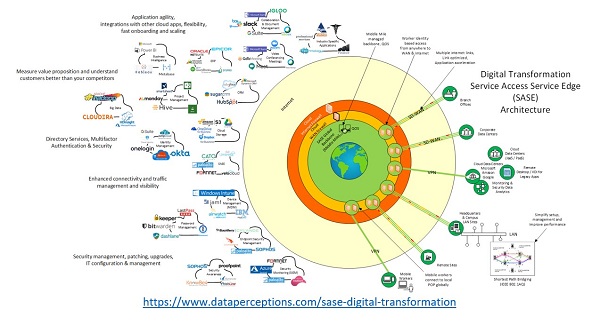Parents often tell their children that the world is their oyster, meaning they can achieve anything they wish in life if they take advantage of opportunities presented. The same is true for organizations undergoing digital transformation… cloud applications — software as a service (SaaS) — can be their oyster. Almost anything is possible, as long as they can make everything work together with the right level of performance, reliability, mobility, and security for the business.
Historically, having to make a bunch of disparate networking, security, and application technologies work together to support business operations has been a challenge. However, a new category of solutions, called secure access service edge (SASE) and pronounced “sassy,” aims to simplify the task of delivering applications to your workforce without compromise.
SASE Architecture
SASE, a term Gartner coined, simplifies and integrates a collection of technologies including: WAN, SD-WAN, remote access, cloud authentication and identity management, network traffic management, encryption, and security. SASE enables people to work with ease, agility, security, and mobility without traditional constraints.
The SASE architecture, shown below, shows how these different types of tools combine in a single platform, allowing connectivity easily and securely. This means users can work just about anywhere while having access to the tools they need, whether those are hosted in the cloud or in a corporate data center.
SASE allows an organization to more easily take advantage of cloud applications and technologies while maintaining secure operations and business agility. In addition, SASE offers the unique advantage of allowing organizations to simplify network, security management, and operations as they transition to cloud applications. Organizations can implement a hybrid of SASE and traditional firewall sites to allow for a smooth transition from on-premises to cloud-based firewalls, or firewall as a service (FWaaS). On-premises firewalls still offer the ability to provide network segmentation at a location.
Governance and Security
An organization can simplify security by applying one set of policies to all users, regardless of location.
Integrating SASE with cloud services like identify management, mobile device management, endpoint security management, and security monitoring can significantly enhance an organization’s security detection and response operational capabilities.
These enhanced capabilities will also make secure operations easier to manage, and improve both the supplier and customer experience. Since SASE allows for a single method of accessing applications securely, organizations can more easily manage a hybrid of on-premises and cloud solutions.
Digital Transformation
The SASE architecture and availability of cloud application delivery has opened up a world of options. It provides the capability to cost effectively deploy applications to any number of people in a workforce — potentially in days instead of months. SASE’s simplicity has reduced costs and deployment time, while increasing business agility and operational reliability.
However, using SASE to support digital transformation doesn’t eliminate the challenge of mapping out requirements, objectives, workflow, and use cases. It can expand the options available, reduce the cost and accelerate deployment, and enable organizations to reduce the risk of deploying applications in the cloud. A good
methodology for identifying requirements for digital transformation is more important than ever.
The rates of productivity increases are accelerating with digital transformation that rely on cloud applications. Businesses that are successful with the digital transformation journey are linking cloud, security, and customer experience.
Customer Experience
Business leaders are reinventing their organizations with the goals of creating an exceptional customer experience and staying ahead of the competition. This digital transformation process requires enhancements to technologies, people, and processes that drive business value.
Cloud-based applications allow businesses to focus on their customers and deliver value through deep understanding. Data analytics and big data have further enabled businesses to understand their target customers better than their competitors. Businesses can use this unique combination of tools and data to measure the value they’re delivering to their customers in ways never before possible. Many cloud-based vendors offer standard integrations with other cloud applications to allow a better fit with business processes.
Tying it all Together
Businesses that adopt a SASE architecture will be able to accelerate their adoption of cloud applications and tools. The architecture will enable a successful digital transformation journey that links cloud applications, security capabilities, and enhanced customer experience. The architecture’s potential can only be fully realized when a sound digital transformation process is applied.
"SCTC Perspective" is written by members of the Society of Communications Technology Consultants, an international organization of independent information and communications technology professionals serving clients in all business sectors and government worldwide.











